Potentialities and Impacts of Biomass Energy in the Brazilian Northeast Region
Abstract
1. Introduction
2. The Historical Importance of Biomass Sources in the Brazilian Northeastern Economy
3. Materials and Methods
3.1. Object of Study
3.2. Energy Potential Estimates
3.2.1. Sugarcane
3.2.2. Firewood
3.2.3. Animal Waste
3.2.4. Municipal Solid Waste (MSW)
3.3. Estimates of Greenhouse Gas Emissions
3.4. Locational Quotient
4. Results and Discussion
4.1. Biomass Availability
4.2. Energy Availability
4.2.1. Sugarcane Derivatives (Bagasse, Ethanol, Straw, and Vinasse)
4.2.2. Firewood
4.2.3. Animal Waste
4.2.4. Municipal Solid Waste
4.3. Municipal Specialization
4.4. Socio-Environmental Impacts
5. Conclusions and Future Trends
Author Contributions
Funding
Institutional Review Board Statement
Informed Consent Statement
Data Availability Statement
Conflicts of Interest
References
- Vogel, J.; Steinberger, J.K.; O’Neill, D.W.; Lamb, W.F.; Krishnakumar, J. Socio-economic conditions for satisfying human needs at low energy use: An international analysis of social provisioning. Glob. Environ. Chang. 2021, 69, 102287. [Google Scholar] [CrossRef]
- González-Eguino, M. Energy poverty: An overview. Renew. Sustain. Energy Rev. 2015, 47, 377–385. [Google Scholar] [CrossRef]
- Owusu, P.A.; Asumadu-Sarkodie, S. A review of renewable energy sources, sustainability issues and climate change mitigation. Cogent Eng. 2016, 3, 1167990. [Google Scholar] [CrossRef]
- International Energy Agency. Data Browser. Available online: https://www.iea.org/statistics/ (accessed on 10 April 2023).
- Guo, M.; Song, W.; Buhain, J. Bioenergy and biofuels: History, status, and perspective. Renew. Sustain. Energy Rev. 2015, 42, 712–725. [Google Scholar] [CrossRef]
- Empresa de Pesquisa Energética (Brasil). Brazilian Energy Balance 2022 year 2021. Braz. Energy Dep. 2022, 1, 292. [Google Scholar]
- Brasil. Ministério do Meio Ambiente. Biomassa Para Energia no Nordeste: Atualidade e Perspectivas [Recurso Eletrônico]/Ministério do Meio Ambiente, Programa das Nações Unidas Para o Desenvolvimento. 2018. Available online: https://www.undp.org/sites/g/files/zskgke326/files/migration/br/Livro_APNE_NE_AGO20.pdf (accessed on 1 September 2022).
- Herreras Martínez, S.; van Eijck, J.; Pereira da Cunha, M.; Guilhoto, J.J.M.; Walter, A.; Faaij, A. Analysis of socio-economic impacts of sustainable sugarcane–ethanol production by means of inter-regional Input–Output analysis: Demonstrated for Northeast Brazil. Renew. Sustain. Energy Rev. 2013, 28, 290–316. [Google Scholar] [CrossRef]
- Cardoso, T.F.; Watanabe, M.D.B.; Souza, A.; Chagas, M.F.; Cavalett, O.; Morais, E.R.; Nogueira, L.A.H.; Leal, M.R.L.V.; Braunbeck, O.A.; Cortez, L.A.B.; et al. A regional approach to determine economic, environmental and social impacts of different sugarcane production systems in Brazil. Biomass Bioenergy 2019, 120, 9–20. [Google Scholar] [CrossRef]
- de Arruda, H.L.S.; dos Santos, J.F.O.; Albuquerque, U.P.; Ramos, M.A. Influence of Socioeconomic Factors on the Knowledge and Consumption of Firewood in the Atlantic Forest of Northeast Brazil. Econ. Bot. 2019, 73, 1–12. [Google Scholar] [CrossRef]
- Alfaia, R.G.d.S.M.; Costa, A.M.; Campos, J.C. Municipal solid waste in Brazil: A review. Waste Manag. Res. J. A Sustain. Circ. Econ. 2017, 35, 1195–1209. [Google Scholar] [CrossRef]
- Forster-Carneiro, T.; Berni, M.D.; Dorileo, I.L.; Rostagno, M.A. Biorefinery study of availability of agriculture residues and wastes for integrated biorefineries in Brazil. Resour. Conserv. Recycl. 2013, 77, 78–88. [Google Scholar] [CrossRef]
- Bolaji, B.O. Effects of Unsustainable Use of Biomass Energy for Cooking and Strategies for Their Reduction in Developing Countries. Dev. Ctry. Stud. 2012, 2, 19–26. [Google Scholar]
- Hakizimana, E.; Wali, U.G.; Sandoval, D.; Venant, K. Environmental Impacts of Biomass Energy Sources in Rwanda. Energy Environ. Eng. 2020, 7, 62–71. [Google Scholar] [CrossRef]
- Majeed, M.T.; Luni, T.; Tahir, T. Growing green through biomass energy consumption: The role of natural resource and globalization in a world economy. Environ. Sci. Pollut. Res. 2022, 29, 33657–33673. [Google Scholar] [CrossRef]
- De Oliveira, F.C.; Coelho, S.T. History, evolution, and environmental impact of biodiesel in Brazil: A review. Renew. Sustain. Energy Rev. 2017, 75, 168–179. [Google Scholar] [CrossRef]
- Butnar, I.; Broad, O.; Solano Rodriguez, B.; Dodds, P.E. The role of bioenergy for global deep decarbonization: CO2 removal or low-carbon energy? GCB Bioenergy 2020, 12, 198–212. [Google Scholar] [CrossRef]
- Benevenuto, R.; Caulfield, B. Measuring access to urban centres in rural Northeast Brazil: A spatial accessibility poverty index. J. Transp. Geogr. 2020, 82, 102553. [Google Scholar] [CrossRef]
- Instituto Brasileiro de Geografia e Estatística. Sistema IBGE de Recuperação Automática. Available online: https://sidra.ibge.gov.br/home (accessed on 1 September 2022).
- Howard, D.B.; Soria, R.; Thé, J.; Schaeffer, R.; Saphores, J.-D. The energy-climate-health nexus in energy planning: A case study in Brazil. Renew. Sustain. Energy Rev. 2020, 132, 110016. [Google Scholar] [CrossRef]
- Associação Brasileira Empresas de Limpeza Pública e Resíduos Especiais (ABRELPE). Panorama dos Resíduos Sólidos no Brasil 2020. São Paulo, Brazil: 2021. (In portuguese). Available online: www.abrelpe.org.br (accessed on 1 September 2022).
- Singh, P.; Suman, A.; Tiwari, P.; Arya, N.; Gaur, A.; Shrivastava, A.K. Biological pretreatment of sugarcane trash for its conversion to fermentable sugars. World J. Microbiol. Biotechnol. 2008, 24, 667–673. [Google Scholar] [CrossRef]
- Chandel, A.K.; da Silva, S.S.; Carvalho, W.; Singh, O.V. Sugarcane bagasse and leaves: Foreseeable biomass of biofuel and bio-products. J. Chem. Technol. Biotechnol. 2012, 87, 11–20. [Google Scholar] [CrossRef]
- Hofsetz, K.; Silva, M.A. Brazilian sugarcane bagasse: Energy and non-energy consumption. Biomass Bioenergy 2012, 46, 564–573. [Google Scholar] [CrossRef]
- União da Indústria de Cana-de-Açúcar e Bioenergia. Setor Sucroenergético. Available online: https://unica.com.br/setor-sucroenergetico/etanol/ (accessed on 1 September 2022).
- de Souza Dias, M.O.; Maciel Filho, R.; Mantelatto, P.E.; Cavalett, O.; Rossell, C.E.V.; Bonomi, A.; Leal, M.R.L.V. Sugarcane processing for ethanol and sugar in Brazil. Environ. Dev. 2015, 15, 35–51. [Google Scholar] [CrossRef]
- Parsaee, M.; Kiani, M.K.D.; Karimi, K. A review of biogas production from sugarcane vinasse. Biomass Bioenergy 2019, 122, 117–125. [Google Scholar] [CrossRef]
- Nadaleti, W.C.; Lourenço, V.A.; Filho, P.B.; dos Santos, G.B.; Przybyla, G. National potential production of methane and electrical energy from sugarcane vinasse in Brazil: A thermo-economic analysis. J. Environ. Chem. Eng. 2020, 8, 103422. [Google Scholar] [CrossRef]
- da Silva, M.B.; dos Santos Morais, A. Avaliação Energética do Bagaço de Cana em Diferentes Níveis de Umidade e Graus de Compactação; XXVIII Encontro Nacional de Engenharia de Produção: Rio de Janeiro, Brazil, 2008. [Google Scholar]
- REN 21. Energy Units and Conversion Factors. Available online: https://www.ren21.net/gsr-2018/pages/units/units/ (accessed on 9 November 2022).
- Salomon, K.R.; Silva Lora, E.E. Estimate of the electric energy generating potential for different sources of biogas in Brazil. Biomass Bioenergy 2009, 33, 1101–1107. [Google Scholar] [CrossRef]
- Eggleston, H.S.; Buendia, L.; Miwa, K.; Ngara, T.; Tanabe, K. 2006 IPCC Guidelines for National Greenhouse Gas Inventories. Volume 1—General Guidance and Reporting; Annex 8A.1 Prefixes, units and abbreviations, standard equivalents; IPCC: Geneva, Switzerland, 2006. [Google Scholar]
- Sheng, C.; Azevedo, J.L.T. Estimating the higher heating value of biomass fuels from basic analysis data. Biomass Bioenergy 2005, 28, 499–507. [Google Scholar] [CrossRef]
- Melikoglu, M.; Menekse, Z.K. Forecasting Turkey’s cattle and sheep manure based biomethane potentials till 2026. Biomass Bioenergy 2020, 132, 105440. [Google Scholar] [CrossRef]
- De Oliveira, A.C.L.; de Oliveira Resende, M.; Silva, E.G.M.; dos Santos Renato, N.; Martins, M.A.; Sequinel, R.; Machado, J.C. Evaluation and optimization of electricity generation through manure obtained from animal production chains in two Brazilian mesoregions. J. Clean. Prod. 2021, 316, 128270. [Google Scholar] [CrossRef]
- Ferreira, L.R.A.; Otto, R.B.; Silva, F.P.; De Souza, S.N.M.; De Souza, S.S.; Junior, O.A. Review of the energy potential of the residual biomass for the distributed generation in Brazil. Renew. Sustain. Energy Rev. 2018, 94, 440–455. [Google Scholar] [CrossRef]
- Instituto Brasileiro de Geografia e Estatística. Estimativas de população residente no Brasil e unidades da federação com data de referência em 1° de julho de 2021. Available online: https://www.ibge.gov.br/estatisticas/sociais/populacao/9103-estimativas-de-populacao.html?=&t=resultados (accessed on 1 December 2022).
- Towprayoon, S.; Tomonori, I.; Chiemchaisri, C.; Abdel-Aziz, A.O. 2019 Refinement to the 2006 IPCC Guidelines for National Greenhouse Gas Inventories. Vol. 5 Waste, Ch. 3 Solid Waste Disposal; IPCC: Geneva, Switzerland, 2019. [Google Scholar]
- Empresa de Pesquisa Energética—EPE Informativo Técnico. 011/2022, EPE/DEA/SMA Dez/2022, 13. Technical Report. Available online: https://www.epe.gov.br/sites-pt/areas-de-atuacao/estudos-socioambientais/SiteAssets/Paginas/Emissoes-de-Gases-de-Efeito-Estufa/Informativo%20Tecnico_11-2022_fatores%20de%20emiss%C3%A3oSMA.pdf (accessed on 1 December 2022).
- Eggleston, H.S.; Buendia, L.; Miwa, K.; Ngara, T.; Tanabe, K. 2006 IPCC Guidelines for National Greenhouse Gas Inventories. Volume 2—Energy; Ch 2. Stacionary Combustion; IGES: Kanagawa, Japan, 2006. [Google Scholar]
- Liu, W.; Zhang, Z.; Xie, X.; Yu, Z.; von Gadow, K.; Xu, J.; Zhao, S.; Yang, Y. Analysis of the Global Warming Potential of Biogenic CO2 Emission in Life Cycle Assessments. Sci. Rep. 2017, 7, 39857. [Google Scholar] [CrossRef]
- Júnior, E.P.S.; da Silva, M.V.B.; Simioni, F.J.; Junior, P.R.; Menezes, R.S.C.; Junior, L.M.C. Location and concentration of the forest bioelectricity supply in Brazil: A space-time analysis. Renew. Energy 2022, 199, 710–719. [Google Scholar] [CrossRef]
- Bichel, A.; Telles, T.S. Spatial dynamics of firewood and charcoal production in Brazil. J. Clean. Prod. 2021, 313, 127714. [Google Scholar] [CrossRef]
- Instituto Brasileiro de Geografia e Estatística. Divisão Regional do Brasil em Regiões Geográficas Imediatas e Regiões Geográficas Intermediárias: 2017; IBGE Coordenação de Geografia, Ed.; IBGE Coordenação de Geografia: Rio de Janeiro, Barzil, 2017; ISBN 9788524044182.
- Piacenti, C.A.; Alves, L.R.; De Lima, J.F. O Perfil Locacional do Emprego Setorial no Brasil. Rev. Econ. Nordeste 2008, 39, 481–502. [Google Scholar]
- Santos, S.C.J.; Gomes, L.J. Consumo e procedência de lenha pelos estabelecimentos comerciais de Aracaju-SE. Rev. Fapese 2009, 5, 155–164. [Google Scholar]
- GIODA, A. Características e procedência da lenha usada na cocção no Brasil. Estud. Avançados 2019, 33, 133–150. [Google Scholar] [CrossRef]
- Eduardo Luiz, G. Rios Neto. Indicadores IBGE—Estatística da Produção Pecuária. Inst. Bras. Geogr. Estatística 2021, 1, 91. [Google Scholar]
- Embrapa Suínos e Aves (Brazilian Agricultural Research Corporation). Annual Report 2019/Editors Monalisa Leal Pereira, Lucas Scherer Cardoso; Embrapa Suínos e Aves: Concórdia, Brazil, 2020. [Google Scholar]
- Pedroso, L.G.; Lages, A.M.G.; Silva, R.P. As estruturas canavieira e citrícola em Alagoas, Pernambuco e São paulo. Rev. Política Agrícola 2015, 24, 88–101. [Google Scholar]
- Santos Júnior, E.P. Concentração e Distribuição Espacial da Oferta Brasileira de Bioeletricidade Florestal-1° Lugar-Categoria: Graduação; VI Prêmio Serviço Florestal Brasileiro em Estudos de Economia e Mercado Florestal. 2018. Available online: http://repositorio.enap.gov.br/handle/1/3826 (accessed on 6 March 2023).
- Agência Nacional de Energia Elétrica. Sistema de Informações de Geração da ANEEL. Available online: http://www2.aneel.gov.br/aplicacoes/capacidadebrasil/OperacaoCapacidadeBrasil.cfm (accessed on 5 September 2018).
- Coelho Junior, L.M.; Burgos, M.D.C.; Santos Júnior, E.P. Concentração regional da produção de lenha da Paraíba. Ciência Florest. 2018, 28, 1729. [Google Scholar] [CrossRef]
- Rabaia, M.K.H.; Abdelkareem, M.A.; Sayed, E.T.; Elsaid, K.; Chae, K.-J.; Wilberforce, T.; Olabi, A.G. Environmental impacts of solar energy systems: A review. Sci. Total Environ. 2021, 754, 141989. [Google Scholar] [CrossRef]
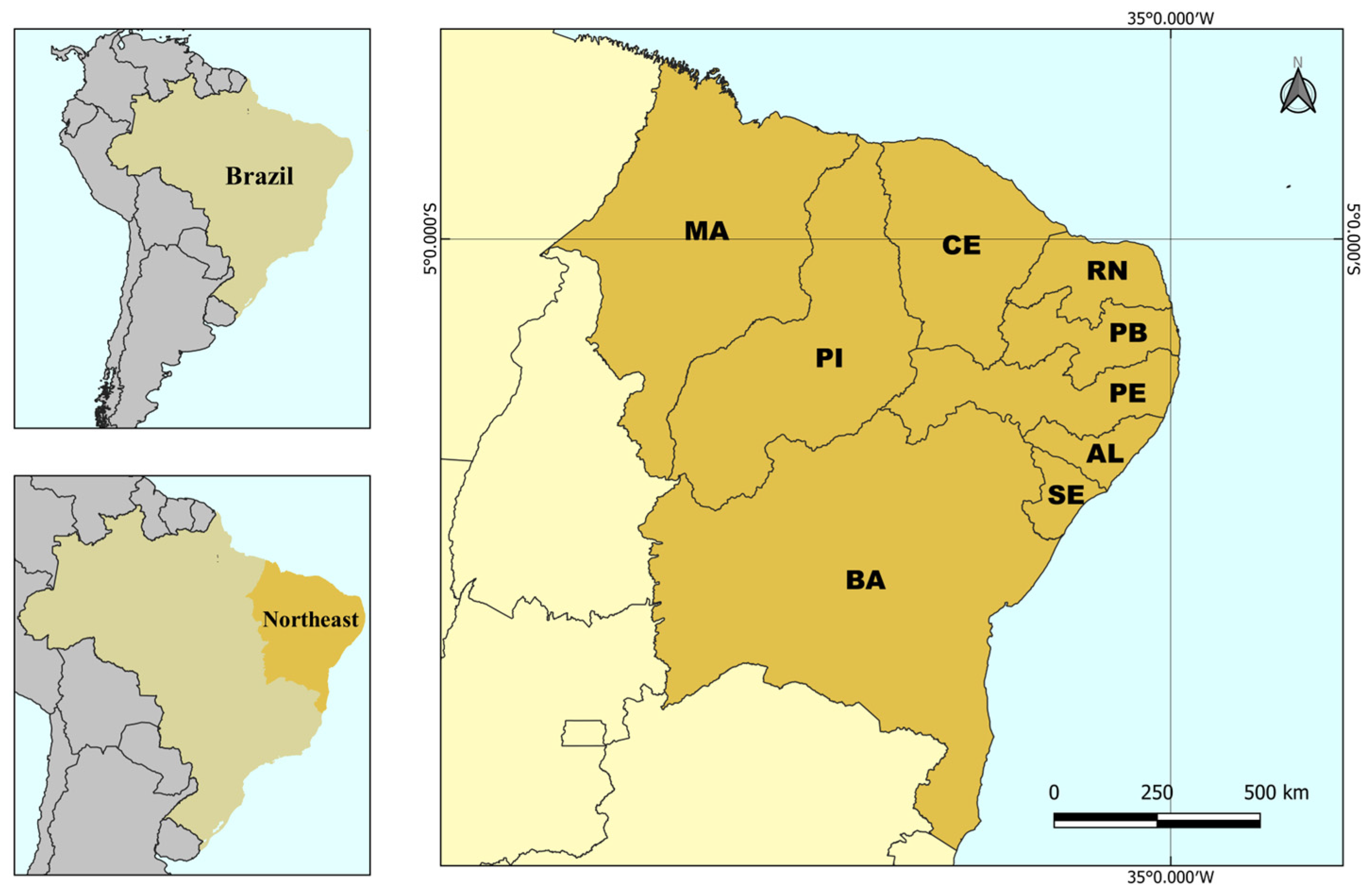
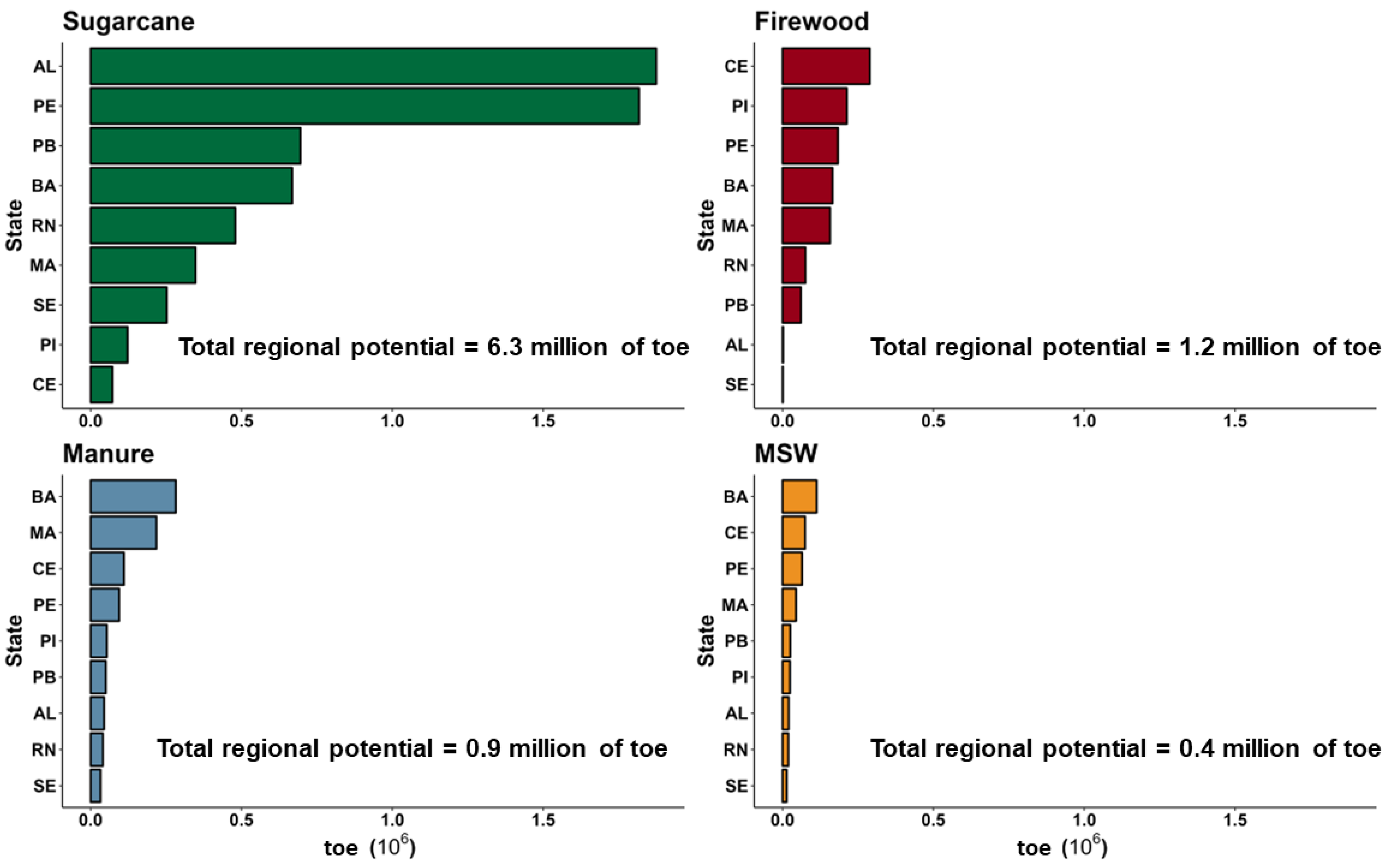
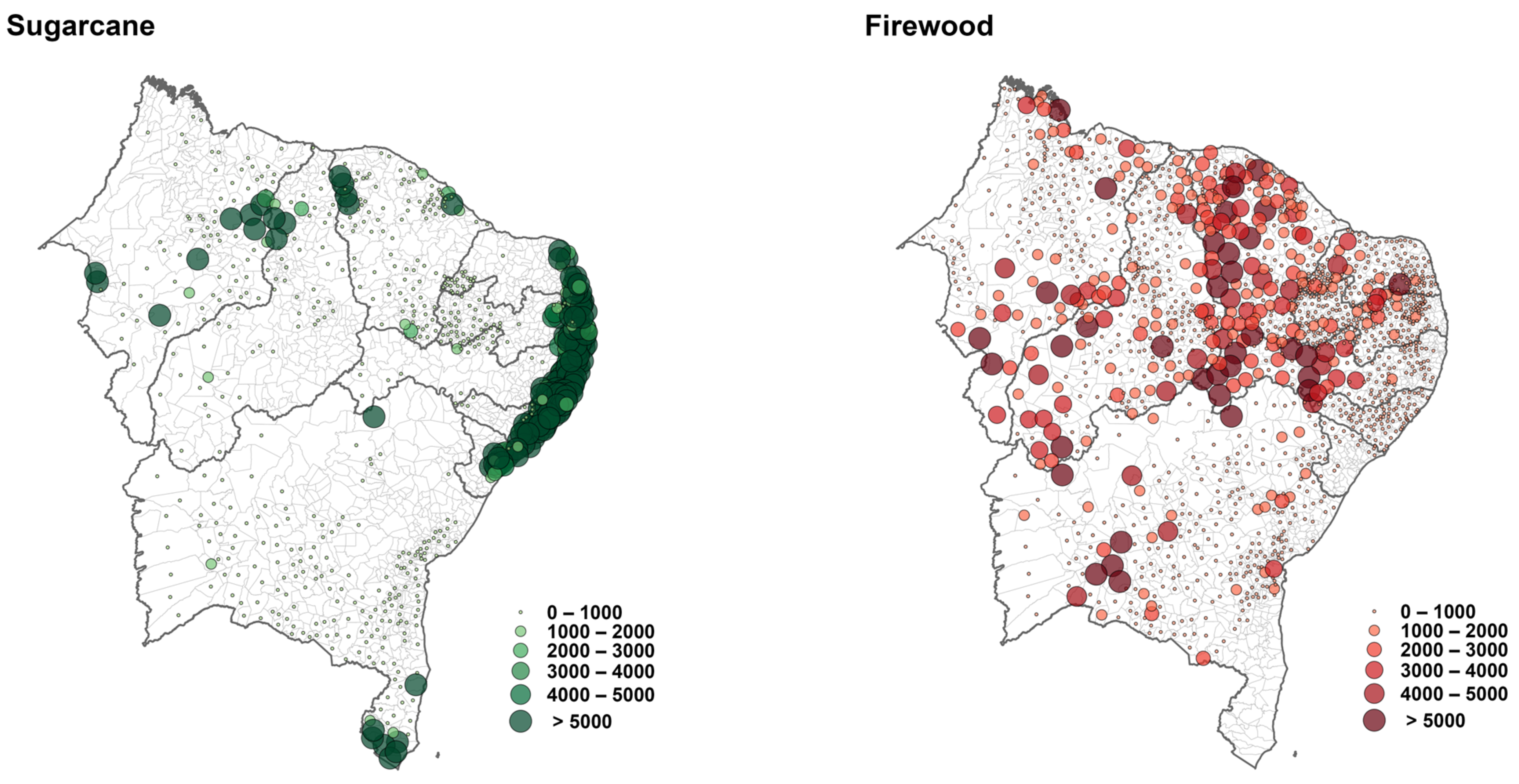
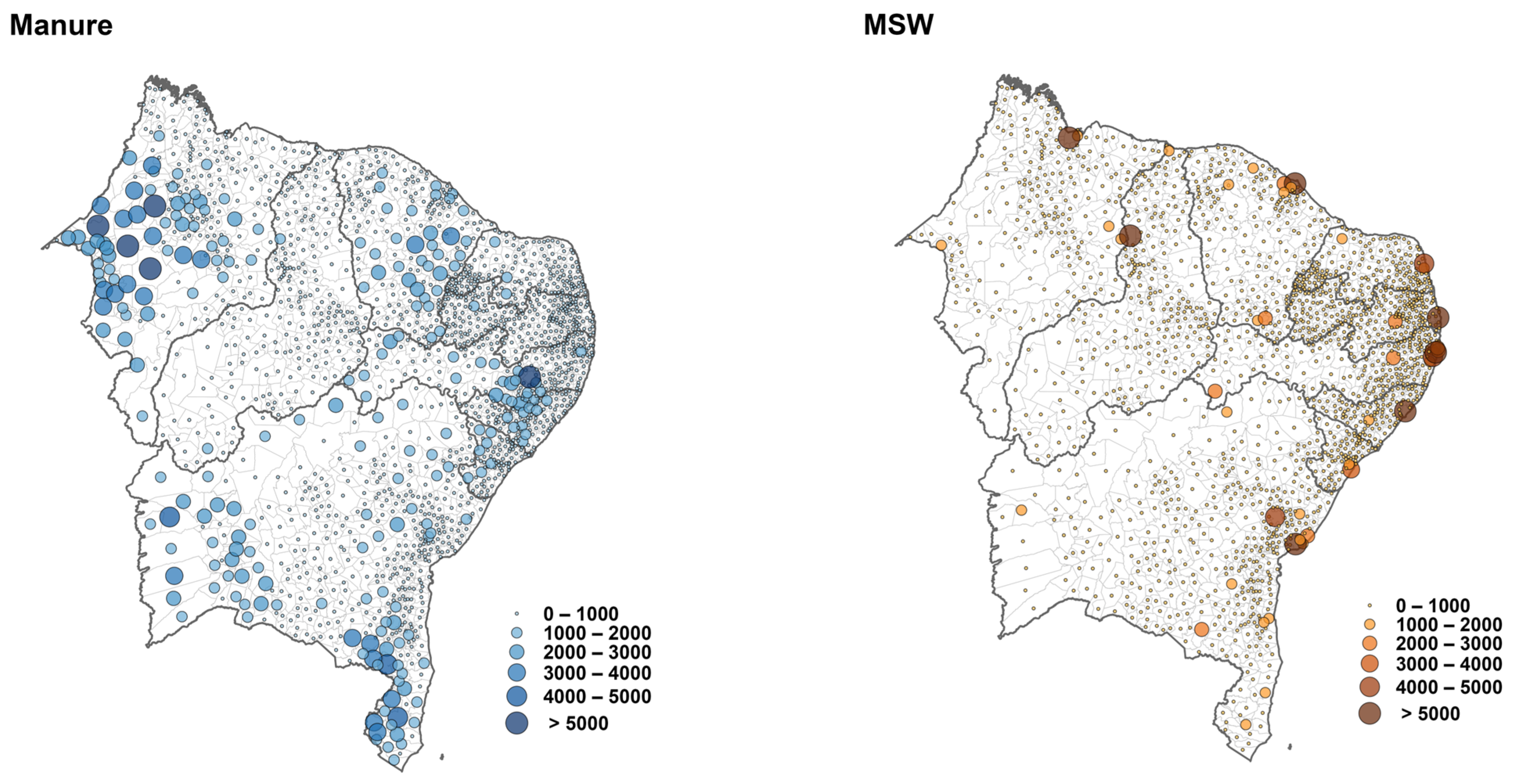

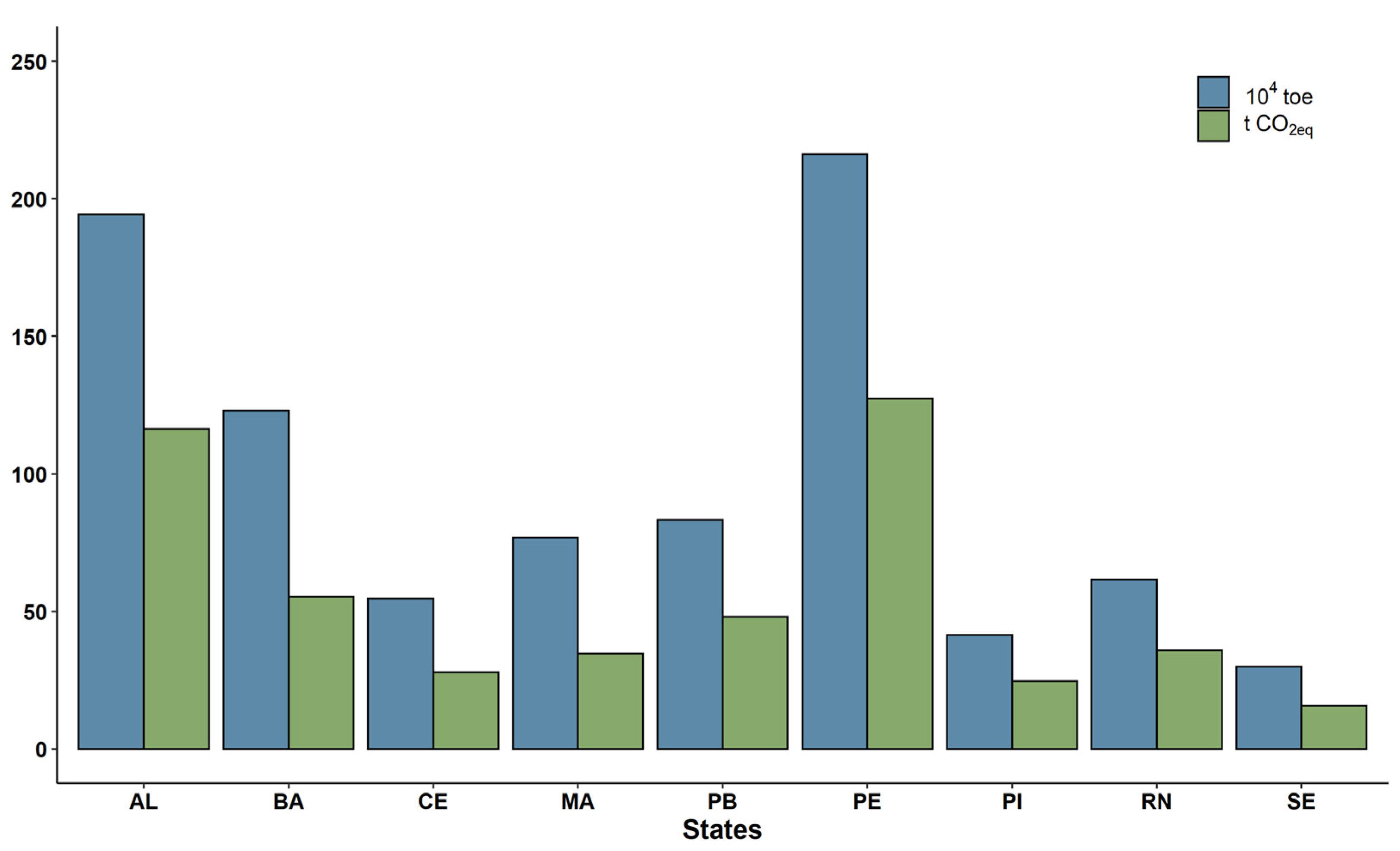
| Fraction | Unit | Energy (MJ) | Toe * ×10−3 | Reference |
|---|---|---|---|---|
| Straw | kg | 9.5186 | 0.227 | Silva et al. [29] |
| Sugarcane bagasse | kg | 9.5186 | 0.227 | Silva et al. [29] |
| Ethanol | L | 21.2 | 0.506 | REN 21 [30] |
| Biogas | m3 | 20.92 | 0.500 | Salomon et al. [31] |
| State | Sugarcane | Firewood | MSW * | Animal Waste |
|---|---|---|---|---|
| Alagoas (AL) | 15.294 | 0.004 | 0.885 | 9.324 |
| Bahia (BA) | 5.450 | 0.360 | 4.894 | 60.261 |
| Ceará (CE) | 0.588 | 0.629 | 3.243 | 22.613 |
| Maranhão (MA) | 2.838 | 0.343 | 1.939 | 45.648 |
| Paraíba (PB) | 5.674 | 0.132 | 1.115 | 10.611 |
| Pernambuco (PE) | 14.827 | 0.400 | 2.811 | 19.946 |
| Piauí (PI) | 1.002 | 0.464 | 1.073 | 10.996 |
| Rio Grande do Norte (RN) | 3.913 | 0.166 | 0.844 | 8.487 |
| Sergipe (SE) | 2.058 | 0.002 | 0.593 | 6.817 |
| Northeast | 51.643 | 2.501 | 17.398 | 194.706 |
Disclaimer/Publisher’s Note: The statements, opinions and data contained in all publications are solely those of the individual author(s) and contributor(s) and not of MDPI and/or the editor(s). MDPI and/or the editor(s) disclaim responsibility for any injury to people or property resulting from any ideas, methods, instructions or products referred to in the content. |
© 2023 by the authors. Licensee MDPI, Basel, Switzerland. This article is an open access article distributed under the terms and conditions of the Creative Commons Attribution (CC BY) license (https://creativecommons.org/licenses/by/4.0/).
Share and Cite
Santos Júnior, E.P.; Silva, E.G.M.; Sousa, M.H.d.; Dutra, E.D.; Silva, A.S.A.d.; Sales, A.T.; Sampaio, E.V.d.S.B.; Coelho Junior, L.M.; Menezes, R.S.C. Potentialities and Impacts of Biomass Energy in the Brazilian Northeast Region. Energies 2023, 16, 3903. https://doi.org/10.3390/en16093903
Santos Júnior EP, Silva EGM, Sousa MHd, Dutra ED, Silva ASAd, Sales AT, Sampaio EVdSB, Coelho Junior LM, Menezes RSC. Potentialities and Impacts of Biomass Energy in the Brazilian Northeast Region. Energies. 2023; 16(9):3903. https://doi.org/10.3390/en16093903
Chicago/Turabian StyleSantos Júnior, Edvaldo Pereira, Elias Gabriel Magalhães Silva, Maria Helena de Sousa, Emmanuel Damilano Dutra, Antonio Samuel Alves da Silva, Aldo Torres Sales, Everardo Valadares de Sa Barretto Sampaio, Luiz Moreira Coelho Junior, and Rômulo Simões Cezar Menezes. 2023. "Potentialities and Impacts of Biomass Energy in the Brazilian Northeast Region" Energies 16, no. 9: 3903. https://doi.org/10.3390/en16093903
APA StyleSantos Júnior, E. P., Silva, E. G. M., Sousa, M. H. d., Dutra, E. D., Silva, A. S. A. d., Sales, A. T., Sampaio, E. V. d. S. B., Coelho Junior, L. M., & Menezes, R. S. C. (2023). Potentialities and Impacts of Biomass Energy in the Brazilian Northeast Region. Energies, 16(9), 3903. https://doi.org/10.3390/en16093903







